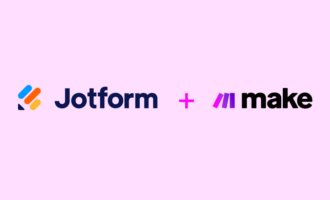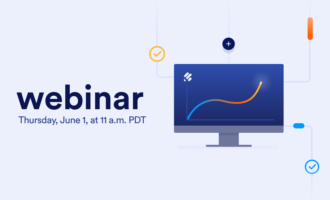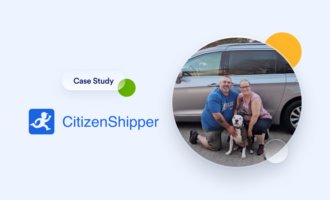By now you’ve probably seen, scanned, or skirted other articles on digital workflow automation. Everyone’s talking about what it is and how it can make your company more productive and efficient.
But what does that really mean, and what practical steps would you take to get started?
If you’re still struggling to answer these questions — and don’t have a clear vision of what digital workflow automation would actually look like in your business — then you’re in the right place!
By the end of this article, you’ll have a solid understanding of the concept of digital workflow automation, lots of examples of how you can use it, and even a way to get started with Jotform. Let’s dive in — and hopefully make this the last digital workflow automation article you’ll ever need to read!
Interested in taking your digital workflows to the next level? Dive into this comprehensive white paper on digital transformation for actionable tips and real-world examples.
An overview of digital workflows
A digital workflow is a business process or task that team members complete using digital tools — such as software applications — instead of doing them manually. Businesses often create automated digital workflows for repetitive administrative tasks that require less human intervention but are still integral to operations.
Digital workflows tend to be faster and more accurate than manual ones. Even better, using digital tools allows you to automate low-level tasks, like entering data or replying to simple customer queries. That frees up employees to work on higher-value activities (like solving more complex customer problems or developing new products).
Let’s see how that might look in practice.
One workflow that’s ripe for digitization and automation is expense approval. Instead of passing around or emailing receipts and itemized expense lists, you can fully automate many parts of the process. You can set up automation “rules” so expense reports that meet certain criteria are approved and those that don’t are denied.
This simple digital automation can save the accounting team a considerable amount of time and speed up the process of expense reimbursements.
The benefits of implementing digital workflows
There are many advantages to implementing automated digital workflows in an organization:
- Your processes run themselves. When workflows are automated, they happen regardless of how busy employees are. Automation ensures that processes run without any hiccups — day in and day out.
- You always have a record of your activities. “Digital processes offer better traceability and audit trails, ensuring compliance with regulatory requirements and enhancing transparency across operations,” says Sergey Solonenko, founder and CMO of Algocentric Digital Consultancy, a fractional CMO service that strategizes digital transformations for SaaS brands. Status updates, requests, due dates, and task owners are always available in the digital workflow for everyone to see.
- You have fewer errors to deal with. Most automated digital workflows don’t require any human intervention. This eliminates human error, which can easily occur in manual processes and workflows. For example, your employee could input incorrect information during data entry, while a digital tool can’t make the same mistake.
- Your operational costs go down. “Digital workflows automate repetitive tasks, streamline operations, and reduce manual input errors, significantly boosting overall productivity,” says Solonenko. “By minimizing the reliance on paper…and optimizing resource allocation, digital workflows can significantly lower operational costs.”
- You can make better business decisions. Digital workflows can aggregate and analyze operational data, notes Solonenko. You can glean valuable insights from this data that can help you make strategic decisions for the business, such as ways to improve your processes and eliminate bottlenecks.
- Your team collaborates more smoothly. Many digital workflow tools offer real-time updates to employees and enable shared access to workflow documents, allowing people to work together seamlessly, regardless of where they’re located.
Digital workflow examples to inspire your organization
It’s possible to transform lots of processes with digital workflow automation, and business owners are trying them all! Just about any industry and department can use it, so the possibilities are endless. Here are some examples that might spark ideas for your own company.
- Marketing: Algocentric uses digital platforms to manage nearly all aspects of its marketing campaigns, from planning and execution to analytics and optimization. For instance, you could use it to automatically publish social media posts, send out nurture emails to prospects, analyze content for SEO purposes, and more.
- Human resources: HR departments can enhance many processes with digitized workflows, such as requesting vacation, conducting assessments, and approving payroll. Human resources professionals can even automate certain parts of candidate screening for open roles or offboarding employees who are leaving the organization.
- Customer service, support, and relationship management: “Digital CRM systems enable us to maintain detailed customer profiles, track interactions, and personalize customer engagement, fostering stronger relationships and improving customer satisfaction,” says Solonenko. You can also use automation tools to notify and contact customers about specific events, such as when invoice payments are due or when it’s time to reorder stock of a product.
- Information technology: Your IT team can use automated digital workflows to manage service tickets, prioritize tasks, and allocate resources to specific projects. It can also help manage employee access to specific technology or data, ensuring the company can maintain its privacy and security protocols.
- Project management and operations: Budgeting, time management, and scheduling could all benefit from digital workflow automation. Generating and distributing reports, collecting daily status updates, and sending team notifications and reminders are areas where you can make things easier with automation.
“Leveraging digital project management tools, we maintain real-time visibility into project status, resource allocation, and deliverables, enhancing collaboration and ensuring timely completion,” says Solonenko.
- Legal: Your legal department can use automated digital workflows to generate standard contractual documents and identify errors or duplications within contracts or clauses. Staff can also set up automatic signature reminders, alerts for compliance deadlines, and more.
- Finance: From data entry to resource allocation, this area is one where automated digital workflows can have a major impact. “Digitizing financial workflows, from invoicing and payments to financial reporting, has streamlined our financial operations, improved accuracy, and provided real-time financial insights,” says Solonenko.
Best practices for designing digital workflows
Excited to get started? Before you do, here are a few things to think about to ensure your efforts yield the best possible results.
- Set clear objectives. Determine what you want to achieve by digitizing the workflow. “Identify specific goals and KPIs to ensure the digitization aligns with your business objectives,” says Solonenko. It’s important to deliver measurable benefits, so be sure to identify the manual processes that will have a big impact when digitized, especially those that often lead to pain points and bottlenecks in the business.
- Involve all relevant parties from the get-go. It’s vital to include your stakeholders from the start when designing the automated workflow. These include the people who currently conduct the workflow manually, their managers, and technology leaders within the business. Develop your digitization plan together to consider a diverse range of perspectives.
- Choose the right digital automation tools. There are many digital workflow automation tools available on the market, so select ones based on your specific needs and pain points. Think about scalability, user-friendliness, integration capabilities, customer support, and user training. Be sure to test the digitization solution extensively before implementing it on a large scale.
- Focus on the user experience. While digitized workflows don’t require a lot of human interaction, it’s likely that your employees will still be using the solution in some ways. Consider how your employees’ user experience will change with the new technology involved and whether it will require new on-the-job training and support.
- Don’t do everything all at once. Make changes in phases so that you have opportunities for feedback and adjustments, says Solonenko. “This approach helps in addressing challenges effectively and ensures continuous improvement.” It’s best to refine workflows as you digitize them and then scale them once they’re fully optimized.
- Prioritize data security and privacy. When moving from manual to digital workflows, you’ll have to ensure the security of your data differently. Prioritize data protection and implement robust security measures while complying with data privacy regulations, advises Solonenko. Cybersecurity threats are real, and they affect even the most prepared organizations. Have multiple layers of security in place to protect your company’s vital data.
Jotform: A powerful tool for automating your digital workflows
Jotform is one of the simplest digital workflow automation tools available.
It’s perfect for streamlining document-related processes in any kind of organization, from small businesses to large enterprises. It supports a range of industries, including education, healthcare, insurance, banking, human resources, and more.
With Jotform, your organization can
- Digitize many paper-based processes: Create surveys to collect feedback from customers or employees or make custom forms to complete business processes such as taking orders. It’s also great for event signups, webinar registrations, and course enrollments. Jotform’s advanced features like conditional logic and answer piping make it easy to create the customized digital process you need.
- Automate approvals: Use Jotform Approvals templates to set up automated approval workflows for business processes related to leave requests, expense approvals, project management, and more.
- Manage large amounts of digital data: If you want to collect, organize, and manage data in an all-in-one workspace, try out Jotform Tables. Then you can use Jotform Report Builder to help you visualize the collected data and generate insights from it.
- Integrate with your other business systems: Integration with other platforms is easy with Jotform. Connect Jotform with other tools like Google Sheets, Salesforce, Slack, and more to automate the flow of data across platforms and ensure seamless collaboration between departments and systems.
Jotform can help you digitize and automate all kinds of crucial business processes. Sign up for free to try it out.
Photo by freestocks.org





















































































Send Comment: